![JCO_1557]() Assessing and Preventing Falls in the Nursing Home
Assessing and Preventing Falls in the Nursing Home
According to a 2012 study by Centers for Disease Control and Prevention, between half and three-quarters of nursing home residents fall each year, accounting for nearly half of all Emergency Room visits by nursing home residents. As alarming as this statistic may seem, there is a bright side: most of these falls are preventable and proper training and education can help reduce the number of falls among nursing home residents.
As part of the comprehensive services we provide, Therapy Center works with the nursing and administrative staff in our partner facilities to continuously provide educational opportunities and up-to-date information on industry best practices. In working to reduce the number of falls in nursing home facilities, it is important to review each fall instance and understand why the fall occurred. Asking the right questions is the first step to understanding risks and keeping residents safe while still allowing them a sense of independence.
Begin at the Beginning
There are 10 important questions to ask at the time of a fall that will help provide insight into what went wrong:
1. Ask the resident: Are you ok?
2. Ask the resident: What were you trying to do?
3. Ask the resident or determine: What was different this time that may have contributed to the fall?
4. What was the position of resident?
– Did the resident fall near a bed, toilet, or chair? How far away were they?
– Was the resident on his/her back, front, left side or right side?
– What was the position of the resident’s arms and legs?
5. What was the surrounding area like?
– Was the area noisy, busy, or cluttered?
– Was there poor lighting or low visibility?
– What was the position of furniture and equipment in the area? Is the bed height correct?
6. What was the floor like?
– Was the floor wet, uneven, or shiny?
– Is the floor carpet or tile?
7. What was the resident wearing?
– Was the resident wearing shoes, socks, or slippers?
– Was the resident wearing poorly-fitting clothes?
8. Was the resident using an assistive device?
– Was the resident using a walker, cane, wheelchair, merry walker, or other device?
9. Was the resident wearing glasses and/or hearing aids?
10. Who was in the area when the fall occurred?
![JCO_1654]() Teamwork Multiplies Success
Teamwork Multiplies Success
Answering the 10 questions above will provide a good overview of the circumstances leading up to the fall. Armed with this knowledge, the resident’s team of healthcare providers can work together to conduct a root cause analysis, used to determine exactly what happened, why it happened, and what can be done to prevent it from happening again.
In conducting a root cause analysis, there are 3 areas to investigate:
Internal Evidence:
What does the place of the fall indicate?
At Bedside = likely orthostatic hypotension, can be incorrect bed placement
5 feet away = balance/gait deficits
15 feet away = strength/endurance deficits
What does the resident’s mood status and/or cognitive changes indicate?
Frequent napping may indicate sleep deprivation, which could be a risk factor for increased falls. To help eliminate this risk factor, health care workers can look for ways to minimize interruptions at night, thereby providing residents with the best opportunity for getting at least 8 hours of uninterrupted sleep.
What medications is the resident taking that could contribute to fall risks?
Medications can often have unintended side-effects which contribute to a resident’s potential for falls. In particular, antidepressants, antipsychotics, and diuretics have been found to cause an increased risk of falls in the elderly. It is important for residents’ medical team to determine that all medications are necessary, properly dosed, and being properly taken.
External Evidence:
Remembering that a nursing facility is not an overnight stay for residents, but rather their home – whether short-term or permanently – it is important to create a calming, comfortable environment at all times. Keeping noise levels low and busy activity to a minimum will create a more peaceful home for residents. Rooms that are free of clutter, have adequate lighting and properly placed furniture set residents up for success and eliminate many of the hazards that contribute to fall instances.
Systemic Evidence:
What additional factors could have contributed to a fall? Remember that understanding the details of WHY a fall occurred will help prevent it from ever happening again. Some additional details to investigate that may provide insight into what happened include:
- What time of day did the fall occur?
- Did the fall happen during a shift change or break time?
- What day of week did the fall occur?
- Where was the location of fall?
Therapy Center Can Help
Therapy Center’s therapists are highly-trained to evaluate situations and present skills to assist with identifying possible fall risks. Our therapists will make recommendations, based on their assessments, for environmental adaptations or changes that can help avoid situations where falls would be likely to occur.
Our therapists can make recommendations for proper footwear and correct bed heights based on a resident’s individual needs. In addition, our therapists can evaluate and address any visual deficits that may be causing the resident to fall.
Because we know that it is important that everyone in a nursing facility works together to create the best outcomes for the residents there, Therapy Center’s therapists work diligently to assist and train the staff in our partner facilities, creating a unified team of medical professionals all working toward the common goal of keeping residents safe and providing them with the quality of life that they deserve.
To learn more about Therapy Center’s services in skilled nursing facilities, contact Kristi Fredieu at 337-384-9791or kfredieu@therapyctr.com.





 -Lauren McCraine, Mentor and Occupational Therapist
-Lauren McCraine, Mentor and Occupational Therapist




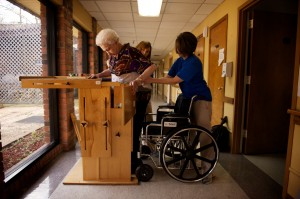
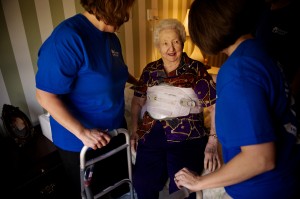


 -Lauren McCraine, Mentor and Occupational Therapist
-Lauren McCraine, Mentor and Occupational Therapist


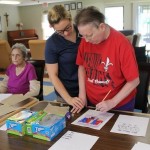

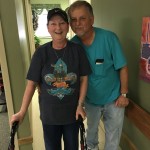

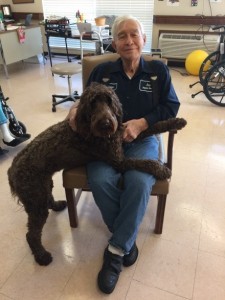
 During the holiday season our therapy team at
During the holiday season our therapy team at 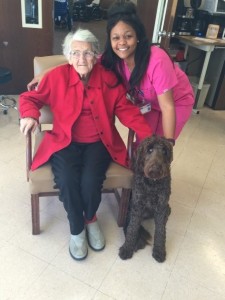 behavior training. Once she completes beginner, intermediate and advanced training courses, Truffle and I together will take the
behavior training. Once she completes beginner, intermediate and advanced training courses, Truffle and I together will take the 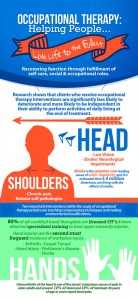

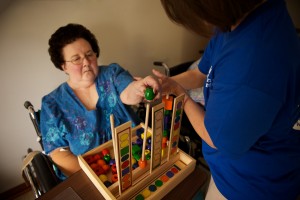
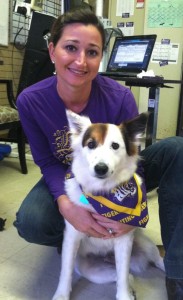 As many of you know from
As many of you know from  placed for all of the residents to see her as they attended therapy. Over time, Abbey’s sight declined and she displayed some cognitive changes causing her to wander off and become “lost” in her very familiar environment, as well as withdraw socially from things she used to enjoy. Abbey’s therapeutic effect became less hands-on as the residents took comfort in just watching her sleep, knowing she would be in her corner. Eventually, I could see in her eyes that the burden of getting in and out of the car (even with me lifting her up and helping her out), walking to and from the nursing home entrance, and even going outside to relieve herself, had become too much for her. As much as she wanted to be by my side, she physically couldn’t keep up. She didn’t give up in the end, when she couldn’t give of herself anymore. As much as it pained her, she kept trying. But I could see it, when she would look at me as if to say, “Please just let me be. Just pet me, love me, and let me be.” This look day in and day out, along with the loss of her senses and ability to get around, led me to the advice of her doctor, which was to let her go.
placed for all of the residents to see her as they attended therapy. Over time, Abbey’s sight declined and she displayed some cognitive changes causing her to wander off and become “lost” in her very familiar environment, as well as withdraw socially from things she used to enjoy. Abbey’s therapeutic effect became less hands-on as the residents took comfort in just watching her sleep, knowing she would be in her corner. Eventually, I could see in her eyes that the burden of getting in and out of the car (even with me lifting her up and helping her out), walking to and from the nursing home entrance, and even going outside to relieve herself, had become too much for her. As much as she wanted to be by my side, she physically couldn’t keep up. She didn’t give up in the end, when she couldn’t give of herself anymore. As much as it pained her, she kept trying. But I could see it, when she would look at me as if to say, “Please just let me be. Just pet me, love me, and let me be.” This look day in and day out, along with the loss of her senses and ability to get around, led me to the advice of her doctor, which was to let her go.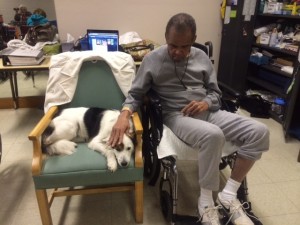 Abbey had 5 “bonus” years of life upon being rescued, and those years were full! Full of more love than any pet I have ever known. The pain is eased when I look back at the memories of my loyal and devoted friend, who brought so much joy to every single life she touched. After learning of her passing, many have shared their memories of Abbey with me and how she has impacted their lives – even people who I had no idea even knew her! She taught me patience and showed unconditional love. She wasn’t just my dog, or just our family dog, a piece of her belonged to everyone who knew her and loved her. Abbey’s spirit lives on inside the walls of Gueydan Memorial, with her own memorial photos displayed in patients’ rooms and with a special hand-painted portrait of Abbey (completed by Robert Baxter upon request of a resident’s family member) that was framed and hung in the nursing home for all to admire. As you can see, Abbey was more than a dog, or a therapy dog, she was one of us.
Abbey had 5 “bonus” years of life upon being rescued, and those years were full! Full of more love than any pet I have ever known. The pain is eased when I look back at the memories of my loyal and devoted friend, who brought so much joy to every single life she touched. After learning of her passing, many have shared their memories of Abbey with me and how she has impacted their lives – even people who I had no idea even knew her! She taught me patience and showed unconditional love. She wasn’t just my dog, or just our family dog, a piece of her belonged to everyone who knew her and loved her. Abbey’s spirit lives on inside the walls of Gueydan Memorial, with her own memorial photos displayed in patients’ rooms and with a special hand-painted portrait of Abbey (completed by Robert Baxter upon request of a resident’s family member) that was framed and hung in the nursing home for all to admire. As you can see, Abbey was more than a dog, or a therapy dog, she was one of us.








